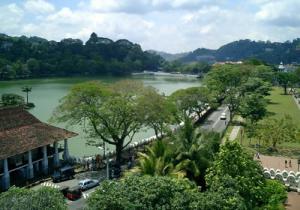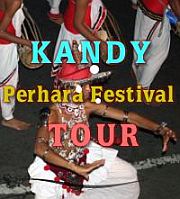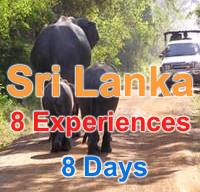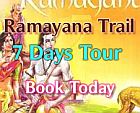Kandy The Hill Country
 Sri Lanka's fascinating variety in climate and landscape, and rich cultural
heritage has for many centuries attracted travellers from all over the world. It
still continues to do so offering within an area of only 70,000 sq. km. a
diversity of attraction and a way of life which combines a dynamic new present
with a tradition-bound past.
Sri Lanka's fascinating variety in climate and landscape, and rich cultural
heritage has for many centuries attracted travellers from all over the world. It
still continues to do so offering within an area of only 70,000 sq. km. a
diversity of attraction and a way of life which combines a dynamic new present
with a tradition-bound past.
Kandy is the English name given to old city of Maha Nuvara (Senkadagalapura).
Nowhere is this rich diversity more evident than in Kandy, the charming hill capital and the cultural city, 129 km. from Colombo and situated 465 metres above sea level. The Colonial rulers called it Kandy for Kanda in Sin ha la, meaning a hill.
The capital of the Kandyan Kingdom in the 16th century and the seat of much of Sri Lanka's culture, this Royal City fell into the hands of the British when the last Kandyan King, Sri Vikrama Rajasinha was captured by them in 1815. The city was born in the 14th century and became the capital of the Kandyan Kingdom in the 16th century.
Nestling midst low hills, and looped by Sri Lanka's largest river, the Mahaweli, Kandy is still the home of the arts and crafts, music, dance and song which flourished during the reign of the king-their patron.
This beautiful city, with its hills and valleys, rivers, lakes and cascading waterfalls around the hills, has its share of hallowed and living shrines, of the Buddhists, Hindus, Christians and the Muslims in the city and around. But, to the Buddhists, Kandy is a Sacred City.
Travelers sensitive to atmosphere discover Kandy's greatest charm in the aura of age and splendor and the very tangible peace that, oriental - style, a crowded market place stocked with fruits, flowers and foodstuffs to buy, and a hive of activity everywhere.
Tours of Kandy
While in Sri Lanka a tour of Kandy is Must. Travel & Culture services offers several options check our Colombo Kandy Tour an ideal tour of 3 days to Kandy
Hotels in Kandy
Hotel Hill Top The Charming Hotel Comprises a Total of 81 Double Rooms Spread Over 3 Floors. Guests Are Welcomed Into the Lobby Area With a 24-Hour Reception Service.
Kandy - History
Historical records suggest that Kandy was first established by the King Wickramabahu (1357-1374 CE) near the Watapuluwa area, north of the present city, and named Senkadagalapura at the time, although some scholars suggest the name Katubulu Nuwara may also have been used. The origin of the more popular name for the city, Senkadagala, could have been from a number of sources. These include naming after a brahmin named Senkanda who lived in a cave near the city, after a queen of King Wickramabahu named Senkanda or after a colored stone named Senkadagala. The present name Kandy, an anglicized version of Kanda Uda Rata ("the land of mountains") originated in the colonial era.
 In 1592 Kandy became the capital city of the last remaining independent kingdom
in Sri Lanka after the coastal regions had been conquered by the Portuguese.
Invasions by the Portuguese and the Dutch (16th, 17th and 18th century) and also
by the British (most notably in 1803) were repelled. The last ruling dynasty of
Kandy were the Nayaks of Kandy. Kandy preserved its independence until it
finally fell to the British in 1815. The British deposed the king, Sri Wikrama
Rajasingha, and all claimants to the throne, thus ending the last traditional
monarchy of Sri Lanka, and replaced it with their monarchy.
In 1592 Kandy became the capital city of the last remaining independent kingdom
in Sri Lanka after the coastal regions had been conquered by the Portuguese.
Invasions by the Portuguese and the Dutch (16th, 17th and 18th century) and also
by the British (most notably in 1803) were repelled. The last ruling dynasty of
Kandy were the Nayaks of Kandy. Kandy preserved its independence until it
finally fell to the British in 1815. The British deposed the king, Sri Wikrama
Rajasingha, and all claimants to the throne, thus ending the last traditional
monarchy of Sri Lanka, and replaced it with their monarchy.
View of the lake from Rajapihilla Mawatha, on the right the golden roof of the Temple of the Tooth, top left a Toque MacaqueAs the capital, Kandy had become home to the relic of the tooth of the Buddha which symbolises a 4th-century tradition that used to be linked to royalty since the protector of the relic was seen fit to rule the land. Thus, the Royal Palace and the Temple of the Tooth were associated with the administrative and religious functions of the capital city. Even after its conquest by the British, Kandy has preserved its function as the religious capital of the Sinhalese and a place of pilgrimage for Buddhists, namely those belonging to the Theravada school.
Portuguese invasions in the 16th century and 17th century were entirely unsuccessful. The kingdom tolerated a Dutch presence on the coast until 1761, when Kirti Sri attacked and overran most of the coast, leaving only the heavily fortified Negombo intact. When a Dutch retaliatory force returned to the island in 1763, Sri abandoned the coastline and withdrew into the interior. When the Dutch continued to the jungles the next year, they were constantly harassed by disease, heat, lack of provisions, and Kandyan sharpshooters, who hid in the jungle and inflicted heavy losses on the Dutch. The Dutch launched a better adapted force in January of 1765, replacing their troops' bayonets with machetes and using more practical uniforms and tactics suited to speedy movement. They were initially successful, capturing the capital, but they took a deserted city, and the Kandyans withdrew to the jungles once more, refusing to engage in open battle. The Dutch, worn down by constant attrition, came to terms in 1766.
Urban morphology
The city of Kandy lies at an altitude of about 500 m above sea level. Its plan developed around two open spaces: an elongated square at the end of which are the administration buildings of the old capital, and an artificial lake that is quadrangular in form. A public garden adds to the openness of the city's spatial organisation.
On the north shore of the lake, which is enclosed by a parapet of white stone dating to the beginning of the 19th century, are the city's official religious monuments, including the Royal Palace and the Temple of the Tooth, known as the Dalada Maligawa (daḷadā māligāva). Reconstructed in the 18th century, the Dalanda Maligawa is built on a base of granite that was inspired by the temples of Sri Lanka's former capital city, Anuradhapura. An array of materials (limestone, marble, sculpted wood, ivory, etc.) contribute to the richness of this temple. Throughout this small holy city, a number of recent Buddhist monasteries can be found.
Kandy has now grown out to encompass Peradeniya, home to the University of Peradeniya and the Botanical Gardens, Katugastota to the north, and east to Kundasale, Tennekumbura and Gurudeniya.
World Heritage Site
The tooth sanctuaryThe monumental ensemble of Kandy is an example of construction that associates the Royal Palace and the Temple of the Tooth (palace of the tooth relic). It was one of a series of temples built in the places where the relic, the actual palladium of the Sinhalese monarchy, was brought following the various relocations of the capital city.
The Palace of the Tooth relic, the palace complex and the holy city of Kandy are associated with the history of the dissemination of Buddhism. The temple is the product of the last peregrination of the relic of the tooth of Buddha and the testimony of a cult which continues to be practiced today.

Festivals
Kandy is also popular because of the annual festival known as the Esala Perahera (ˈɶsələ ˌperəˌhɶrə) in which one of the inner caskets used for covering the tooth relic of Buddha is taken in a grand procession through the streets of the city. This casket is taken on a tusker of royal caste. The procession includes traditional dancers and drummers, flag bearers of the provinces of the old Kandyan kingdom, the Nilames (lay custodians of temples ) wearing their traditional dresses, torch bearers and also the grandly attired elephant. This ceremony which is annually held in the months of July or August, attracts large crowds from all parts of the country and also many foreign tourists
Shopping
Kandy offers a variety of shopping destinations, ranging from colourful and vibrant markets to exquisite boutiques. The Kandy City Centre shopping complex is currently under construction.
Culinary
Kandy has a modest range of restaurants, as well as an abundance of confectionaries. A range of cuisines is available including Chinese, European, Sri Lankan, Indian and some multinational fast food outlets.
Nightlife
Kandy offers a reasonable nightlife. Nightclubs are mainly found in Hotels, but there are numerous bars and pubs in the city that have a more local atmosphere.
Botanical garden
Peradeniya Botanical garden The Botanical Garden of Peradeniya is situated about 5 km to the west of the city centre at Peradeniya and is visited by 1.2 million people per year.
SOME TEMPLES OF KANDY
Dalada Maligawa the Temple of the Sacred Tooth Relic is the “ lodestar of the Buddhists", dating back to the 16th century AD. One of the most specticular section of this temple ; the patthirippuwa or the Octagon, was added by the king of Kandy in the early 19th century. He also built the Kandy Lake. Rituals are enacted daily in the Temple to venerate the relic, accompanied by flute playing and drumming. Public honour is paid to it when the Esala Perahcra or Procession of the month of Esala in July/ August each year. A golden canopy was constructed recently over the relic Chamber.
Malwatta and Asgiriya Monasteries
The two most important Buddhist Monasteries in Sri Lanka are on the two sides
of the lake. The chief incumbents of these two temples are the senior
ecclesiastics of the Buddhist order in Sri Lanka. The Malwatta monastery on the
southern side across the lake is embellished with 18th century architectural
design and planning. The higher ordination of the sangha, the monks, takes place
annually in both these temples. The Asgiriya Temple is situated to the western
side of the city at Asgiriya. In one of the shrine rooms of this temple is a
gigantic statue of the Recumbant Buddha. In Asgiriya is also found the cremation
ground of the Kandyan royalty.
Gadaladeniya, Lankatilaka and Embckkc Temples
known as the "western Shrines" are situated close together on the Kadugannawa-Peradeniya road, 16km west of Kandy. Gadaladeniya is built of stone and scenically sites on a rock. The seated Buddha image, lacquered doors, wall murals and carved stone friezes are worth seeing. The temple reminds us of the south Indian architectural influence of the period. Lankatilaka temple is a magnificent building shining in white against the blue sky in the back ground. A brick building in three storeys, it has a peculiar architectural design. Amidst the painted doors of wood and frescoes still bright with their original paint on walls and ceilings in the shrine room is found a superb seated image of the Buddha. The Embekke Temple is a Deistic Shrine dedicated to God Kataragama. This temple is famed for its carved woodden pillars with intricate designs. The pillars leap to life with dancers, musicians, wrestlers, legendry beasts and birds. Nearby are the ruins of an ancient Rest House with similar pillars carved in stone. All the above described monuments belong to the 14th century.
Dodanwela Dcvalc and Suriyagoda Viharc are
situated in the village of Kiribatkumbura along the main road close to the
above temples. Suriyagoda Vihare is said to have built originally in the 15th
century. But the buildings that you see today belong to the 18th century- It has
an image house built on stone pillars on which strong wooden cross beams run to
support the shrine that housed a Buddha image. This is called a Tcmpita Vihara.
This temple is also noted for its murals of the Kandyan period of the 18th
century. The Dodanwela Dcvale is of historic interest as the temple at which
king Rajasinha of Kandy offered his crown to the Presiding God after his great
victory over the Portuguese in the 17th century.
Hindagala Temple is picturesquely situated on a rock close to the University
Campus at Peradeniya along the Galaha Road. It has rock inscriptions dating back
to the 6th century that speaks of the history of this temple. Amidst the ruined
temple paintings of the 6th century are found paintings on the walls of the t^tnple
belonging to different periods of recent history.
Gangarama and Degaldoruwa Temples are
approachable along the Tennekumbur< Road by the side of the Temple of the Tooth Relic. Both the Viharas are cav temples of the 18th century and arc famous for the Kandyan murals. The first temple has a standing Buddha image and the second has a Reclining image of the Buddha in the main shrine. The Gangarama is the closest to the town. The frescoes depicting the Buddhist Jataka Tales, represented as scenes from everyday life in cotemporary Kandy, are some of the finest examples of Buddhist Temple Art in Sri Lanka.
DAY TOURS FROM KANDY
1. Nuwara Eliya.
77 kilometres from Kandy, it is a mountain city where the climate is always spring through the spectacular Ramboda Pass and the finest Tea in the world. In Nuwara Eliya visits to tea estates, boating on Lake Gregory, golf on a mile - high course, a visit to world's end and to the Hakgala Botanical gardens could be organised.
2. Mahiyangana
72 kilometres across the Mahaweli river through the country of Vedda aborigines and dazzling panoramic views of mountain gorges and ravines to one of the sixteen Sacred places of Sri Lanka. Legend has it that stupa at Mahiyangana was founded in the Buddha's life time, to enshrine his Hair Relic gifted by him to a king of Lanka minerals abound on the Buddha's first visit to the island. The road to Mahiyangana is by the side of the Victoria and Randenigala reservoirs.
3. Aluviharc, in the Matale
town is found the renowned cave temple where in 88 BC. the Buddha's teachings were first committed to writing. For four centuries the Teachings of Buddha had been handed down orally. Resplendent scenery and visits to spice gardens and cocoa estates arranged.
4. Dambulla 72 kilometers,
halfway between Kandy and Anuradhapura to the famous Rock Temple once roofed with beaten gold by a devout king. It contains many hundreds of Buddha images and a large murals of the Kandyan Period all over the walls and ceilings of the five cave temples.
5. Sigiriya
96 kilometers, to the palace of a 5th century parricide king ; famous for its water garden, one of the oldest in Asia and the frescoes of beautiful women and its Lion stairway
6. Knuckles Group
32 kilometers, and unexplored range of mountains where rare plant life and



